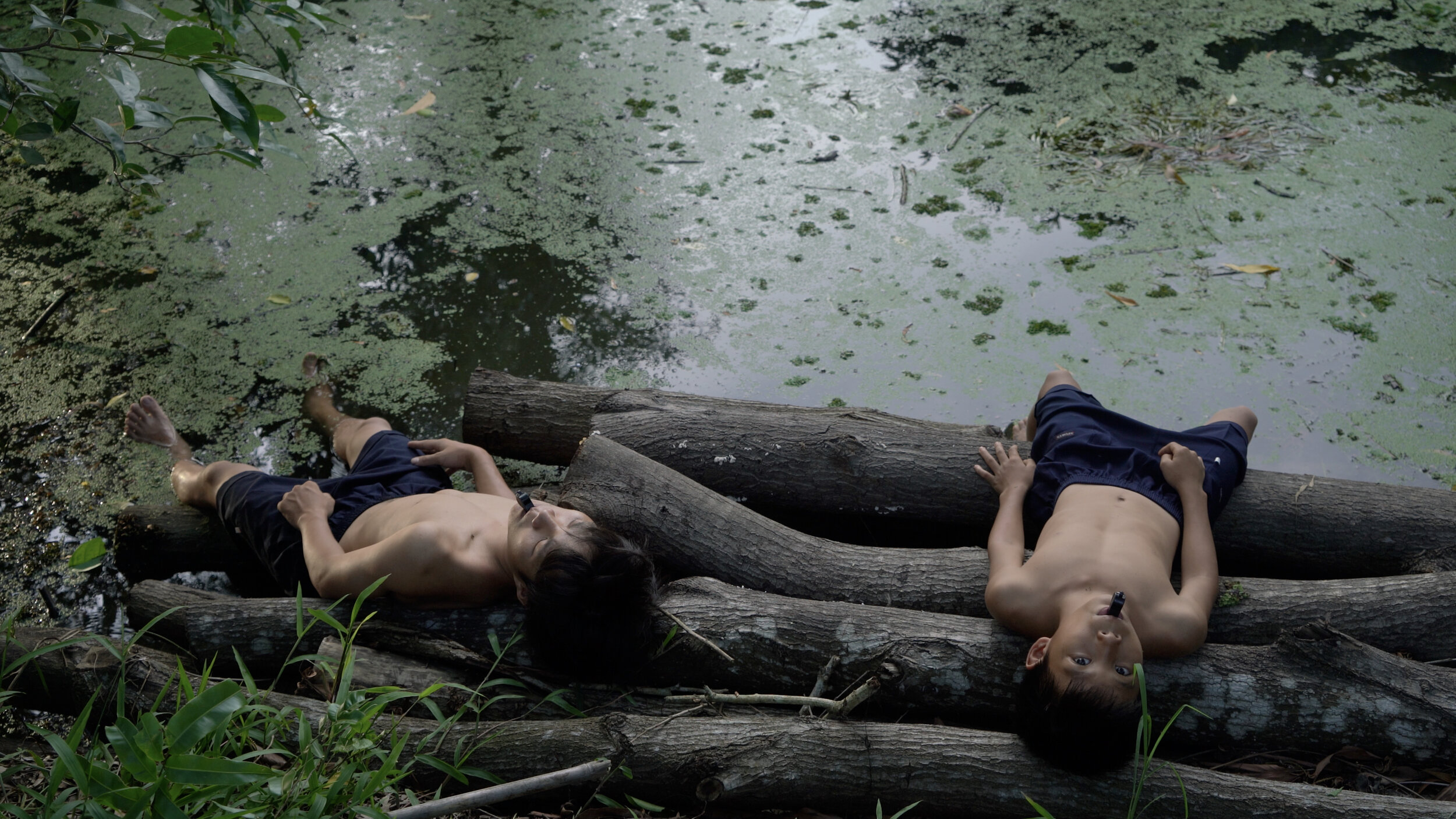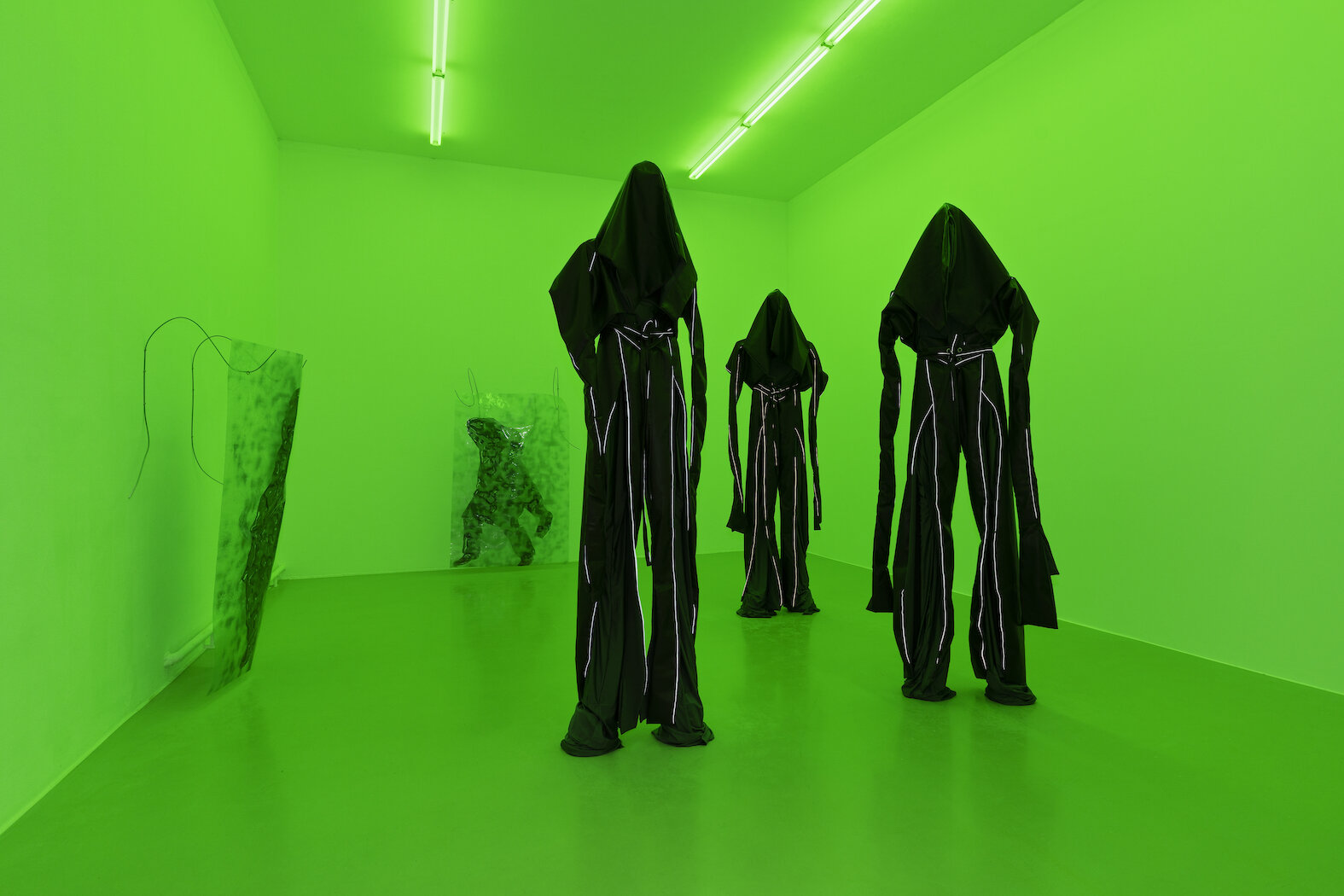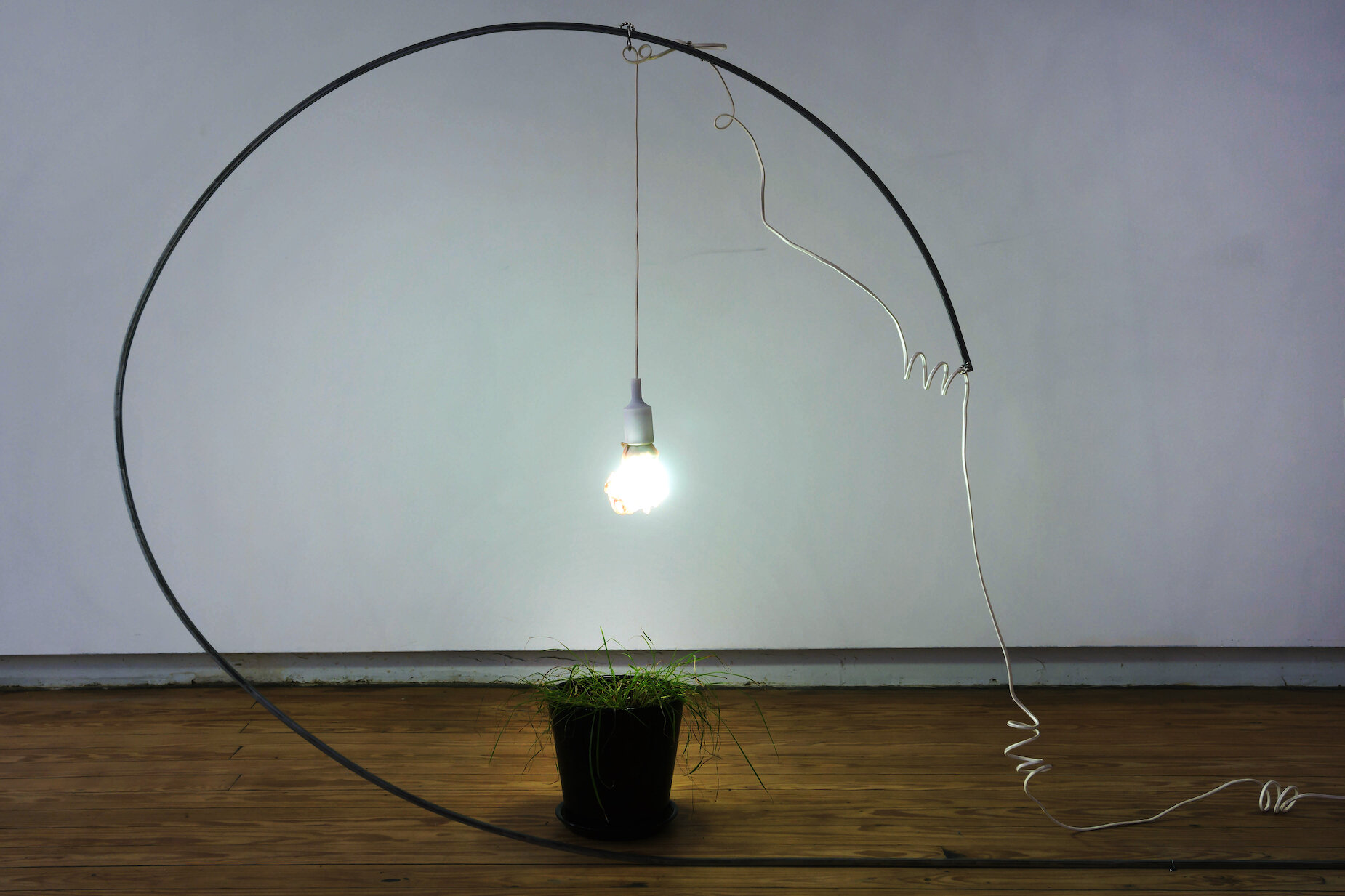MOMENTA 2021 — LA BIENNALE SENTIE ET FLEURISSANTE
Port Radium Mine Rock, de la série Great Bear Money Rock, 2019. Impressions sur soie, dimensions variables. Photo: Erin Siddall. Commandée par MOMENTA Biennale de l’image et la Toronto Biennial of Art. © Erin Siddall
Entrevue avec Stefanie Hessler et Maude Johnson, de l’équipe commissariale 2021 de MOMENTA Biennale de l’image.
Avec sa cinquantaine d’artistes de l’international et ses quinze expositions présentées à travers la métropole, la 17e édition de la biennale MOMENTA est assurément l’un des rendez-vous les plus attendus de la rentrée culturelle montréalaise. La programmation artistique, développée autour du thème Quand la nature ressent/Sensing Nature, promet une exploration multidisciplinaire des intersections entre justice environnementale et justice sociale.
À quelques semaines du lancement, Résidence s’est entretenu avec la commissaire Stefanie Hessler, basée à Trondheim en Norvège, et l’adjointe à la direction et au commissariat de MOMENTA, Maude Johnson, afin d’en apprendre davantage sur les ancrages locaux et conceptuels de l’événement. Les perspectives institutionnelles, personnelles et théoriques des commissaires s’allient au fil de la conversation alors qu’elles nous dévoilent les coulisses de cette édition, suspendue entre art et nature.
Maude, vous évoluez au sein de MOMENTA depuis l’édition 2017. Qu’implique ou signifie réaliser une biennale à Montréal dans le paysage artistique actuel?
MJ. Réaliser une biennale, à mes yeux, c’est trouver des façons de parler de et à la multiplicité de personnes et de postures qui composent nos communautés locales. Cette sensibilité se reflète directement dans les thèmes que nous développons avec les commissaires invité·es. Nous sommes toujours à la recherche d’enjeux ayant le potentiel d’encourager le dialogue et, surtout, de résonner avec des conversations déjà en cours sur notre scène artistique. Notre engagement se traduit également par le maillage avec les partenaires d’exposition et les artistes, maillage qui est indissociable de cette volonté de créer du sens ici, dans et pour notre localité. Tous nos projets d’exposition, par exemple, sont étroitement développés en collaboration avec chaque lieu de diffusion de manière à s’arrimer le plus pertinemment et sensiblement possible aux spécificités de chacun.
Stefanie écrit dans l’un des textes d’exposition: «Un corail n’est pas un corps — il est plusieurs. […] Comme les corps multiples d’un corail, cette section de la biennale met en lumière nos relations avec les autres.» Je trouve que cette idée de la multiplicité exprime magnifiquement ce qu’est MOMENTA en 2021. Celle-ci existe à travers plusieurs corps, lieux, à travers ses relations avec différentes entités qui forment, ensemble, la biennale.
A Money Rock, de la série Great Bear Money Rock, 2019. Photographie, dimensions variables. Photo: Tsēmā Igharas. Commandée par MOMENTA Biennale de l’image et la Toronto Biennial of Art. © Tsēmā Igharas
Sous quels angles ces spécificités locales sont-elles réfléchies en relation au format expographique d’une biennale internationale ?
MJ. Nous observons depuis quelques années une tendance vers la création ou la valorisation de biennales «locales», ou mettant l’accent sur leur écosystème artistique immédiat dans une volonté de démonter le modèle hégémonique de la mégaexposition «globalisée». Notre approche chez MOMENTA est moins d’envisager Montréal, ou le Québec, comme un sujet en lui-même, mais plutôt de se poser la question: que pouvons-nous offrir à Montréal? Qu’apportons-nous, que générons-nous comme sens pour notre milieu? Nous pensons que la réponse peut simultanément être alimentée par un apport local et international.
Un autre aspect fondamental à cette notion de spécificités locales touche à la relation qui unit la biennale au territoire de Tiohtià:ke / Mooniyang / Montréal. En lien avec la thématique de Stefanie, qui s’intéresse entre autres aux formes de coexistence, la question du «ici» a été réfléchie de manière encore plus aiguë cette année pour envisager frontalement le bagage colonialiste qui teinte nos rapports à la terre et à la nature — en plus de ceux à l’institution et au format de l’exposition.
“Nous sommes toujours à la recherche d’enjeux ayant le potentiel d’encourager le dialogue et, surtout, de résonner avec des conversations déjà en cours sur notre scène artistique. ”
Stefanie, your curatorial practice focuses on ecologies and the various interactions between living and non-living forms. What did you want to explore more specifically through this edition of the MOMENTA biennale?
SH. MOMENTA 2021 is titled Sensing Nature. The biennale proposes different ways of relating with nature, celebrating that we are of nature. The title is ambiguous on purpose. Besides proposing that we attune our human senses to nature, it suggests that nature is also a sensing entity: nature senses back. It registers our doings like sunlight bleaching driftwood, but, if cared for, it can also heal. The focus on sensing calls into question the monopoly on knowledge that the visual and cognitive dimensions have largely held since the European Enlightenment, at least in the Global North. The biennale highlights embodied forms of knowing, the wisdom of plants, the intelligence of bioluminescent algae, and the transformations brought about in the couplings of technology with ancestral knowledge.
Wanaawna, 2019. Photographie imprimée sur toile de coton, 1 499,87 × 160 cm. Vues d’installation, Orange County Museum of Art, Santa Ana, 2019. Photo: Taeha Joo. Commandée par l’Orange County Museum of Art. © Carolina Caycedo
“The biennale proposes different ways of relating with nature, celebrating that we are of nature. The title is ambiguous on purpose. Besides proposing that we attune our human senses to nature, it suggests that nature is also a sensing entity: nature senses back.”
And in what ways is your curatorial proposal in dialogue with or distinct from the recent surge of exhibitions on the contemporary art scene that rethink our relationship with nature?
SH. I have been thinking and feeling the troubled state of nature together with artists in various exhibitions and books. One of the questions I keep coming back to is how art can offer us more caring perspectives from which to conjure more just futures. I have explored this question in projects imagining an oceanic worldview that accounts for fluidity and flux, considering the relations between normative heterosexuality and notions of the “natural,” and dreaming ways of undoing the colonial-patriarchal modes of domination that exploit nature and harm human and nonhuman livelihoods.
In the connected struggles for environmental and social justice, we need science as much as we need to acknowledge our senses and talk about our feelings. I follow the Black feminist poet Audre Lorde’s call to trust the power of the erotic, which she describes as the “power which rises from our deepest and non-rational knowledge.” With MOMENTA I propose to expand embodiment, affect and collective healing from the social to the environmental sphere.
Sensing Nature was developed by a curatorial team, composed of Camille Georgeson-Usher, Himali Singh Soin, Maude and yourself. Can you tell us more about the dynamics of this collaborative approach and whether it influenced the final proposal?
SH. I strongly believe in collaboration. Not least during these environmentally and socially tumultuous times, sharing is incredibly important, and so I was really excited when MOMENTA asked me to put together a curatorial team. My proposal for Sensing Nature became deeper, more locally anchored, and more tentacular with the voices of Camille, Himali and Maude. We all have very different backgrounds and live in vastly varying geographies (Delhi, India; London, United Kingdom; Tkaronto / Toronto and the Mississaugas of the Credit, Anishnabeg, Chippewa, Haudenosaunee and Wendat peoples; Galiano Island, Penelakut territory; Frankfurt, Germany; Tråante / Trondheim in Lullisápmi or southern Sápmi, also known as mid-Norway; and Tiohtià:ke / Mooniyang / Montreal itself). Each of these places has its own naturecultures, struggles, wounds and beauty. The biennale echoes this polyvocality of our voices.
“In curatorial practice today, I want to see more realness and care that goes beyond the topics addressed in exhibitions and that transcends institutional structures as well. ”
We had a lot of calls, shared ideas, discussed artists, and supported one another throughout the COVID-19 pandemic and other daily struggles. To me collaboration doesn’t end with work, but I get deeply invested in the lives of my colleagues—my friends—and care about them. To me this is part of integrity, of actually living what we talk about in exhibitions. In curatorial practice today, I want to see more realness and care that goes beyond the topics addressed in exhibitions and that transcends institutional structures as well. To some extent this is already happening in transformative justice activist circles and in some grassroots arts organizations—and we need to acknowledge here the work of womxn, LGBTQ, disabled, Black, Indigenous and People of Colour communities. But there remains a lot to be done, and small actions and true friendships can add a small part in this work. I think (I hope!) that visitors will sense this collaborative spirit in the biennale.
The Garden of a Former House Turned Museum, 2021. Vidéo HD, couleur, son, 20 min 42 s. Interprètes: Sarah Albu, Ruby Kato Attwood, Talia Fuchs, Elizabeth Lima. © Chloë Lum et Yannick Desranleau
Comment le processus de conceptualisation et de production se déroule-t-il au sein de l’organisme MOMENTA sur la période de deux ans qui sépare chacune des éditions?
MJ. Lorsque nous ouvrons la biennale aux publics, le travail sur la prochaine édition est déjà amorcé. En ce moment même [septembre 2021], la recherche de commissaires pour MOMENTA 2023 est engagée. Si l'on suit le fil de production, les invitations seront envoyées au cours de la biennale 2021 et l'hiver 2022 sera consacré à la définition théorique du projet commissarial retenu. C'est à ce stade que l'ancrage au contexte local et la liste des artistes se précisent. Puis, viendront l'élaboration du catalogue, la sélection des œuvres et la conceptualisation des expositions en fonction de chaque lieu de diffusion. Finalement, nous entrons dans une phase de logistique, de montage et de développement éducatif, ce qui nous mène jusqu'aux vernissages!
En fait, le calendrier de production sur deux ans d'une biennale peut s'apparenter aux échéanciers d'une exposition à grand déploiement dans une institution muséale. Pour la taille réduite de notre équipe et le statut indépendant de l'organisme, c'est un rythme de création soutenu et intense, animé par le désir d'offrir à chaque fois des contextes riches de rencontres artistiques et de réflexion.
Hashtag Tmícw, 2014. Peinture d’arpentage, SecwepemcúÍecw. © BUSH Gallery
Looking back, what were the effects of creating a Montreal event from Norway? Any discoveries, learnings?
SH. I have met many incredible artists during the curatorial research, who generously shared their practice with me. BUSH Gallery’s radically inclusive, community-based artistic and curatorial approach is really powerful. For MOMENTA 2021, we invited the collective to develop a carte blanche project at our exhibition partner OPTICA, and I am excited to see what other projects emerge from this. I would love to invite some of the artists I met with to Norway, where Sámi communities are facing issues of green colonialism, and create bridges across the north. Sensing as a mode of knowledge, of critique and of creation will continue to play an important role in my work.
Y a-t-il des projets qui vous sont particulièrement chers parmi l’offre de cette nouvelle édition?
MJ. Je suis très reconnaissante d'avoir pu participer de près au processus de réalisation du projet extérieur TEIONHENKWEN Soutiens de la vie, qui consiste en un jardin collectif situé sur le terrain nord de la Grande Bibliothèque / BAnQ. L'artiste et ethnobotaniste autochtone T'uy't'tanat-Cease Wyss a imaginé un écosystème urbain où se rassemblent des plantes indigènes, en collaboration avec les communautés autochtones de la région. Cette intervention élargit, des points de vue activiste et spirituel, les notions de représentation ou d'image en art contemporain.
Autrement, j'ai très hâte de m'immerger dans l'exposition Des rivières parcourant les corps à Occurrence, où les œuvres de Thao Nguyen Phan et l’installation de Candice Lin et P. Staff présentent une vision différente des notions de toxicité et de transformation. Je suis aussi impatiente de voir la mise en relation des œuvres sculpturales et installatives des six artistes qui investissent l'espace atypique de la Fonderie Darling dans Des tentacules façonnant le monde.
SH. The artists approach nature as an active other that is not there for us to know, own or exploit, but that exists in its own right and with its own rights. For instance, Miriam Simun asks what forms of knowing reside in the smell of a tiny plant on the verge of extinction, Tsēmā Igharas and Erin Siddall explore how a lake remembers—but also forgets—radioactivity in its waters affecting humans and nonhumans alike, and Léuli Eshrāghi unearths how colonial-patriarchal notions of nature affect land, water, and air as well as racialized bodies and queer spirits.
Becoming Alluvium, 2019. Installation vidéo, couleur, son, 16 min 40 s. Photo: Andy Keate. Produit par la Fondation Han Nefkens. © Thao Nguyen Phan
Nocturnal Kinship 1-3, 2018. Similicuir laminé, œillets, polyester, lycra, tissu réflecteur, env. 270 × 80 × 50 cm. Vue d’installation, Kunstverein Hannover, Hanovre, 2020. Photo: Volker Crone. Avec l’aimable autorisation de Croy Nielsen (Vienne) et de The Approach (Londres). © Sandra Mujinga
Corporeal Download (Slip), de la série A Wet Chemical Trace, 2017. Acier, silicone, verre, pinces, lampe de culture, lumière noire, cordon, aimant, Schizachyrium scoparium (herbe), humidificateur, parfum d’Agalinis acuta (Notre jour viendra), 251,46 × 198,12 × 139,70 cm. Vue d’installation, Helena Anrather, New York, 2017. Photo: Miriam Simun. © Miriam Simun
Léuli Eshrāghi, re(cul)naissance, 2020. Techniques mixtes, dimensions variables. Vue d’installation, Biennale of Sydney, Cockatoo Island, 2020. Photo: Jessica Maurer. Commandée par la Biennale of Sydney. © Léuli Eshrāghi
Stefanie, your appointment as curator for MOMENTA 2021 was announced on April 2, 2020, in the midst of a global lockdown… Has the pandemic impacted your working methods?
SH. We developed Sensing Nature entirely during the COVID-19 pandemic. Us curators couldn’t meet in person during the process, but we nevertheless became very close through regular online meetings and by sharing a sense of sadness and urgency. We are commissioning several new artworks and, of course, had to work around a number of limitations, including travel. To give one example, artists and friends Caroline Monnet and Laura Ortman developed a call-and-response method, sending each other printed matter and musical recordings of natural and industrial sites near their homes in Tiohtià:ke / Mooniyang / Montreal and Lenapehoking / Brooklyn. This method allowed them to build a common ground across physical and psychological divides while creating their exhibition at the McCord Museum as part of the biennale.
Has COVID-19 prompted new thoughts around the thematic angle you wanted to examine?
SH. The political dimension of Sensing Nature has become even more pressing since we started working on the biennale. The pandemic is in part due to human impact on our planet, through industrial farming, ongoing eradication of traditional custodians of land, population density and fast-paced global travel, especially in the Global North. At this moment [August 2021], wildfires are rampaging British Columbia, California, Greece and many other places. All of this is not unrelated. MOMENTA 2021 acknowledges these messy entanglements and proposes different, more caring ways of relating with nature in all its forms.
From My House to Yours, 2021. Photographie numérique. Photo (Caroline Monnet): Ulysse del Drago. Photo (Laura Ortman): Amy Schiappa et Laura Ortman. Design: Sébastien Aubin. © Caroline Monnet et Laura Ortman
Is that what you wish the visitors to sense, to feel?
SH. MOMENTA 2021 opens at a time when many of us will be experiencing art in person again for the first time in over a year and a half. The pandemic has certainly influenced the ways us curators and the participating artists have been thinking, feeling and making the exhibitions, and I am sure visitors will feel this as well. For me the question now is how to nurture more just relations as some parts of the world are getting vaccinated (even as an appalling number of people who have access to the vaccine refuse it) and others don’t have access. These patterns of inequity are the same now as before the start of the pandemic. The artworld needs to address them as important issues of social justice, and of environmental justice as well.
The exhibitions in MOMENTA 2021 are offerings to visitors to sense nature not as separate from culture, and to feel her in her intensity and vulnerability on her own terms.
La 17e édition de MOMENTA Biennale de l’image se déroule du 8 septembre au 24 octobre.










